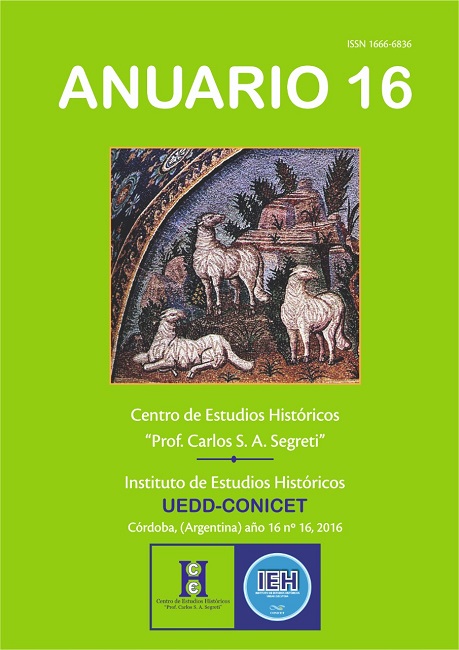La recepción de la Antigüedad tardía a través del cine
DOI:
https://doi.org/10.52885/2683-9164.v0.n16.21921Palabras clave:
tardo-antigüedad, cine, recepciónResumen
El análisis de la percepción del mundo antiguo a través del cine constituye actualmente una especialidad por derecho propio en el estudio de la recepción del pasado. Una revisión de la abundante y creciente bibliografía al respecto permite comprobar cómo el análisis de la recepción cinematográfica de la antigüedad tardía representa un porcentaje minoritario, salvo excepciones como la obra de Martin Winkler o estudios centrados en un largometraje específico. Este fenómeno historiográfico es una proyección del reducido número de títulos que la representación de la tardo-antigüedad presenta a lo largo de la historia del péplum. El objetivo de esta contribución es realizar un análisis de la recepción de la tardo-antigüedad a través del cine, abordando los elementos con que se caracteriza este período en el séptimo arte, tanto per se como en contraste con la representación de otros períodos y aspectos del mundo antiguo, a fin de resaltar este aspecto de la recepción clásica en el cine.
Descargas
Referencias
AGUADO CANTABRANA Óskar, “Revisitando el ejército romano: una aproximación a su representación cinematográfica”, Roda da Fortuna, 2014/1.
BRIGGS JR. Ward W., “Peace and Power in The Fall of the Roman Empire”, Martin WINKLER (ed.), The Fall of the Roman Empire. Film and History, Chichester-Maiden, Wiley-Blackwell, 2009.
BROWN Peter, El mundo de la Antigüedad Tardía, Madrid, Gredos.
CARLÀ Filippo y GOLTZ Andreas “The Late Antique City in Movies”, GARCÍA MORCILLO, Marta HANNESWORTH Pauline y LAPEÑA MARCHENA, Óscar Imagining Ancient Cities in Film. From Babylon to Cincecittà, New York-Londres, Routledge.
DÁVILA VARGAS-MACHUCA Miguel, “Cabiria (G. Pastrone, 1914), una visión colosal de la Segunda Guerra Púnica”, Metakinema. Revista de Cine e Historia, núm. 9, 2011.
DE ESPAÑA Rafael, El péplum: la Antigüedad en el cine, Barcelona, Glenat, 1998.
DORGERLOH Annette, “Competing ancient worlds in early historical film: the example of Cabiria (1914)”, Pantelis MICHELAKIS y Maria WYKE (ed.), The Ancient World in Silent Cinema, Cambridge, Cambridge University Press, 2013.
DUCE PASTOR Elena, “Ágora de Alejandro Amenábar. Nuevo uso cinematográfico del fin de la Antigüedad”, Anuario del Centro de Estudios Históricos “Prof. Carlos S. A. Segreti”, Córdoba, núm. 16, 2017.
ELLIOT B. R. Andrew, “Constructing medieval Worlds: Conventions, Inventions and Images”, Remaking the Moddle Ages. The Methods of Cinema and History in Portraying the Medieval World, Jefferson-Londres, McFarland & Company.
HEATHER Peter, La caída del Imperio Romano, Barcelona, Crítica.
JONES H. M., The Later Roman Empire, 284-602. A social economic and administrative survey, Oxford, Basil Blackwell, 3 volúmenes.
MARTÍN Fernando, “Gladiator (2000), de Ridley Scott. ¿Resurrección del cine de romanos?”, Filmhistoria XI, pp. 1-2, 2001.
MICHELAKIS Pantelis y WYKE Maria (ed.), The Ancient World in Silent Cinema, Cambridge, Cambridge University Press, 2013.
MOLINA GÓMEZ José Antonio, “A través del espejo: preocupaciones contemporáneas por la paz mundial en el cine histórico sobre la Antigüedad”, María Josefa CASTILLO PASCUAL [et.al.] (coord.), Imagines. La Antigüedad en las Artes escénicas y visuales.
PRIETO ARCINEAGA Alberto, “La crisis del Imperio Romano según Dreamworks”, Filmhistoria, vol.XI, núm. 1-2, 2001.
PUCCI Giuseppe, “Peplum, melodrama and musicality: Giuliano l’Apostata (1919)”, Jon SOLOMON, “Gladiator from Screenplay to Screen”, Martin WINKLER (ed.), The Fall of the Roman Empire. Film and History, Chichester-Maiden, Wiley-Blackwell, 2009.
ROSENSTONE Robert A., “Genres, History and Hollywood. A Review Article”, Comparative Studies in Society and History, vol. 27, núm. 2, 1985.
SALVADOR VENTURA Francisco, “Una imagen fílmica rigurosa de la antigüedad tardía: Simón del Desierto de Luis Buñuel”, Habis 38, 2007.
SERRANO LOZANO David, “Cine y Antigüedad: pasado y presente en la pequeña y gran pantalla”, Revista Historia Autónoma, núm. 1, 2012.
WARD Allen M., “History, Ancient and Modern, in The Fall of the Roman Empire”, Martin WINKLER (ed.), The Fall of the Roman Empire. Film and History, Chichester-Maiden, Wiley-Blackwell, 2009.
WARD-PERKINS Bryan, La caída de Roma y el fin de la civilización, Madrid, Espasa-Calpe, 2007.
WILSON Rob, “Ridley Scott’s Gladiator and the spectacle of empire: global/local rumblings inside the Pax Americana”, European Journal of American Culture, vol. 21, núm. 2, 2002.
WINKLER, Martin “A critical appreciation of The Fall of the Roman Empire”, Martin WINKLER (ed.), The Fall of the Roman Empire. Film and History, Chichester-Maiden, Wiley-Blackwell, 2009.
Martin WINKLER, “Cinema and the fall of Rome”, Transactions of the American Philological Association (1974-), vol. 125, 1995.
Martin WINKLER, “Gladiator and the Traditions of Historical Cinema”, Martin WINKLER (ed.), Gladiator. Film and History, Malden-Oxford, Blackwell Publishing.
WOOD Michael, America in the Movies or Santa Maria, It Had Slipped My Mind, New York, New ed, 1989.
WULFF ALONSO Fernando, “Cine e Historia antigua. Notas a propósito de el próximo oriente antiguo y Egipto en el cine”, Scope. Estudios de Imagen, núm. 1, 1996.
Descargas
Publicado
Número
Sección
Licencia
Aquellos autores/as que tengan publicaciones con esta revista, aceptan los términos siguientes:
- Los autores/as conservarán sus derechos de autor y garantizarán a la revista el derecho de primera publicación de su obra, el cuál estará simultáneamente sujeto a una Licencia de reconocimiento de Creative Commons. Se puede compartir, copiar, distribuir, ejecutar y comunicar públicamente la obra, siempre que: a) se cite la autoría y la fuente original de su publicación (revista, editorial y URL de la obra); b) no se use para fines comerciales; c) no se altere, transforme o genere una obra derivada a partir de esta obra.
- Los autores/as podrán adoptar otros acuerdos de licencia no exclusiva de distribución de la versión de la obra publicada (p. ej.: depositarla en un archivo telemático institucional o publicarla en un volumen monográfico) siempre que se indique la publicación inicial en esta revista.
- Se permite y recomienda a los autores/as difundir su obra a través de Internet (p. ej.: en archivos telemáticos institucionales o en su página web) después del proceso de publicación, lo cual puede producir intercambios interesantes y aumentar las citas de la obra publicada. (Véase El efecto del acceso abierto).









